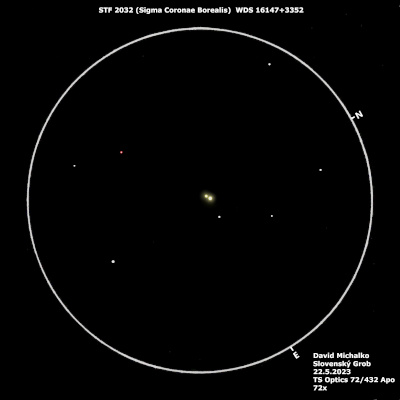Crb
☀5.62/6.49mag
Ø
7''

STF 2032 (Sigma Coronae Borealis) is a quintuple star system located 69 light-years away from the Sun. The primary component (A, Sigma 2) is a spectroscopic binary of spectral class G0V, consisting of yellow main-sequence stars with masses of 1.14 and 1.09 solar masses. The first companion (B, Sigma 1) is also a yellow main-sequence star with a spectral class of G1V and a mass identical to that of the Sun. Components A and B orbit around their common center of mass with a period of 726 years. At a distance of 14,000 AU (approximately 0.22 light-years), a faint inconspicuous star orbits the A-B pair—a spectroscopic binary red dwarf (E) of spectral class M2.5V. The components Ea and Eb of this dwarf orbit around their common center of mass every 52 years. The orbital period of component E around A-B is unknown, likely indicating it is a Common Proper Motion (CPM) member.
72mm - Using a small telescope at moderate magnification, such as 72x in my case, components A and B can be easily separated. Both components exhibit a visibly yellow hue. However, to observe the red dwarf, I had to switch to a larger aperture, as the 72mm refractor couldn't resolve it under the given conditions.
125mm - At this aperture, the companion E became visible as a faint inconspicuous star in the direction of approximately 240° position angle (PA). In the sketch, it is represented in red for identification purposes, even though the color was not discernible in the telescope.